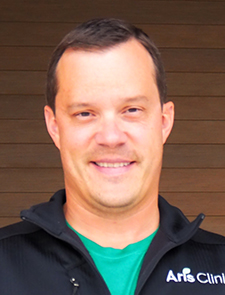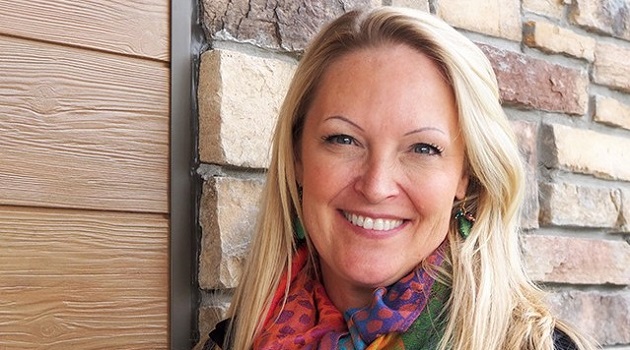MinnPost photo by Andy Steiner
Written By: Andy Steiner | Oct. 7, 2019

Shalene Kennedy: “I saw there was a serious shortage of psychiatrists trained to work with kids, so I decided to step in and help.”
To Dr. Shalene Kennedy, the need is obvious — and ongoing. More than two decades ago, when she was in med school, training to become a psychiatrist, she chose to focus her future practice on children and adolescents.
“Part of why I chose child psychiatry is because it was the most needed profession at that time,” Kennedy said. “One of the numbers that stuck out in my head when I was making that decision was that at that time, if we had 9,000 more child and adolescent psychiatrists, they would not be able to serve the needs of Minnesota alone.”
“That was part of why I do what I do,” she said. “I saw there was a serious shortage of psychiatrists trained to work with kids, so I decided to step in and help.”
By 2005, Kennedy’s impulse led her to open her own small outpatient clinic, focused on medication management for young people. Because she saw a steady and increasing stream of patients and families, she added mental health therapists to her practice.
Yet it wasn’t enough. Clinics like hers were only making a tiny dent in the shortage. “There were just so many kids who needed help,” Kennedy said.
It’s a problem that continues today. In Minnesota, according to the American Academy of Child and Adolescent Psychiatry, there are only 11 child and adolescent psychiatrists per 100,000 children below age 18, well below recommended guidelines.
“I had to quit taking new patients as an outpatient provider when my waiting list was a year long,” Kennedy said. “Imagine being a family in crisis and being told that you need to wait a year to see somebody to manage your child’s medication.”
And beyond those waiting lists, Kennedy said she was discovering that many of her patients actually needed more that she could offer. Too often, her young patients were living in an uncomfortable middle ground: they needed something more than a regular visit with a therapist and a monthly psychiatrist appointment; but their cases also didn’t merit hospitalization, which can be too traumatic for many kids, damaging already fragile mental states.
“I realized that there are a lot of options before hospitalization,” she said, including facilities that offered a partial hospitalization program, or — even better — an intensive outpatient program (IOP), where kids could spend time in a treatment program during the day, but go home to be with their families at night.
“I saw that few of those IOP options existed,” Kennedy said. “I’m talking about the next level of care that you just couldn’t find anywhere, this in-between care where you didn’t want to put your child who was already anxious and avoiding school in with another kid who was physically aggressive, which is more of a partial hospital level behavior. It doesn’t work very well.”
For a time, Kennedy worked with Prairie Care, a Minnesota-based psychiatric care provider that offers inpatient, partial hospitalization and intensive outpatient programs for adults and children with mental illness.
While she appreciated the services Prairie Care offered, Kennedy said, “I kept wanting to do it a little bit differently.” She was particularly interested in developing a program that focused on IOP treatment for children and teens. She believed that IOP programs, if run right, could help countless struggling kids before their problems took over their lives.
Patients best suited for IOP programs fit a specific description, she said: “You’re not quite managing things with outpatient weekly therapy appointments and every few months with a medication provider. It’s just not working. The wheels are really starting to get shaky on the bus. You need to do the next step up, to get things steady again. So many kids are in this situation. I had specific ideas about how I could provide that service for them.”
When the founder of Prairie Care offered to sell her the company’s Woodbury location to make those ideas into reality, she jumped at the opportunity. “I knew I could do what I wanted to do here,” Kennedy said. “I knew I could create a program that could holistically meet the needs of these kids.”
IOP, explained
Kennedy named her program Aris Clinic, and started with an IOP for children ages 5-18 on Currell Boulevard, not far from Tamarack Nature Preserve. The program grew, and this September Kennedy opened a second location, in a new building on Woodwinds Drive, just down the road Woodwinds Hospital.
The Woodwinds clinic’s opening gave Aris Clinic administrators an opportunity to separate their patients into more age-appropriate groupings: Programs for elementary- and early middle school-age kids are located at Aris Clinic-Currell, and teens are at Aris Clinic-Woodwinds.
Aris Clinic offers outpatient psychotherapy, psychiatry and play therapy for kids, but the clinic’s focus is on IOP. Kennedy believes that this approach offers the best chance for young people to learn how to recover from and cope with mental illness. She also thinks it provides the best opportunity for parents and other key adults to learn strategies for supporting their children’s mental health.
By providing safety and focus for their young patients, Kennedy explained, IOPs can help reduce the need for more extreme, and isolating, measures — like full or even partial hospitalization.
“We try to create this very safe space for families and kids to come and heal before it gets to those higher levels,” Kennedy said. “That’s the goal: Keep them in their community. Keep them at their home.”
When children attend an IOP, they take a six-to-eight-week leave from their home school district and enroll in classes that are taught through the treatment program.
At Aris Clinic, Kennedy said, “We maintain a good link to their schools, but by having them with us for six to eight weeks we can really make some major changes medication wise, look at where their school performance is, involve the families, do some individual work as well and in the end, put them back out as a kid and a family that are much more ready with skills and tools to re-enter into their world.”
But Aris Clinic offers no overnight options for patients, which is intentional. “I believe that you should go home,” Kennedy said. Hospitalization, or even partial hospitalization, she continued, “is very artificial. Kids can do really well out of their home environment and then you put them back in and things fall to pieces again. I really love that we have families involved in our program, because it is not just the child who usually needs to make changes.”

MinnPost photo by Andy Steiner
Chad Cartier
Chad Cartier, Aris Clinic director of psychotherapy, said that usually kids who enter Aris Clinic are “have already entered the mental health system through an outside therapist or are on the radar of a pediatrician or somebody at school.”
Most of the time, he explained, these children are not making progress in outpatient treatment and their mental health is starting to impact their school performance and their home life. “They are pulling away from extracurricular activities, they are struggling with their parents,” Cartier said. “The level of impact has gone from something that could be managed in an outpatient level of care to something that needs more focused attention. That’s what we can offer here.”
Before a child enters, Aris Clinic first does an assessment with their families. “They come in and we’ll get an idea of, ‘Okay. Where have you been thus far in your journey? What’s going well? What’s not going well? What is the kid’s level of functioning?’” Cartier said. “We’ll assess if we’re able to meet their needs here within our intensive outpatient program.”
Once it is determined that Aris Clinic is a good match for a child’s needs, they will then unenroll from their home school district and enroll in District 916, an intermediate school district that provides educational services for treatment programs. Young people come to Aris Clinic programs from different Twin Cities school districts and western Wisconsin, Cartier said.
An average day at Aris Clinic involves, “three hours of therapeutic programming and then three hours of classroom learning,” Carter said. “They’re here full days.”
Aris Clinic’s therapeutic programming is focused around, “a particular curriculum to teach social/emotional skills — we try to give them those tools and help them apply those tools throughout the day in the classroom,” Cartier said.
Kids spend time inside and outside, walking and playing outdoor games. “We have family therapy, we have individual therapy and therapists with all different skill sets. They’ll see Dr. Kennedy for medication management.”
At Aris Clinic Woodwinds, for instance, the educational of the day is spent in two small, amply-windowed classrooms in the clinic’s brand-new building. “The District 916 teaching staff is amazing,” Cartier said. “They are teachers who understand this level of care and who want to work with this specific type of kid.”

Courtesy of NAMI-MN
Sue Abderholden
That hasn’t always been the case at all of the state’s IOPs, said Sue Abderholden, executive director of NAMI-Minnesota. “What would happen at some of these day-treatment programs is the staff who were sent by school districts to provide education were not people who really wanted to work with these kinds of kids,” Abderholden said.
In response, NAMI has worked to draft legislation that creates a memorandum of understanding between school districts and day treatment centers that states that, “The day-treatment providers needed to have some control over who is coming into their program to teach the kids.”
Because of the requirement that school districts transport kids to and from their locations, Abderholden said that IOP treatment is seen by many as a lot more complex than residential treatment. And when a parent selects a specific IOP, for their child, districts have been known to balk.
“School districts might say, ‘We aren’t going to bus your kid to that place because this one closer,’” Abderholden said. Parents end up having to be squeaky wheels, advocating for their children — and sometimes even transporting them to their chosen program themselves.
‘There are clear needs’
Even with the expansion of programs like Aris Clinic, however, young Minnesotans still need more mental health care.
The Wilder Foundation released a report earlier this year, “Children’s Intensive Mental Health Services,” that found that “there are clear needs for intensive mental health services in the state of Minnesota,” said Kirsten Anderson, executive director of AspireMN, a statewide association of providers for children, youth and families. “There is a particular shortage of treatment options for adolescents.”
Among treatment options, the report recommended expanding IOPs, Anderson said. “When people are able to seek treatment while living in their home that allows for a longitudinal healing process that allows for the child to be near their family,” Anderson said.
But doing the work right is expensive, she said: “It takes a lot of staff time and is resource intensive.”
And limited reimbursement rates for IOP treatment means that many smaller IOPs struggle to make ends meet, Anderson said. “This is a high-risk, low-reward field meaning that there are incredible complexities that our providers deal with,” she said. “There is a 25 percent gap between the Medicaid rate of payment and the actual cost to provide those services. Because of that, we have significant challenges in recruiting and retaining an excellent workforce.”
In recent years, many of the state’s IOPs have shut their doors. “We have numerous providers who are no longer able to serve children and families because of the pressures and economic realities,” Their absence reverberates in the community, she added: “Programs like these are a truly essential resource for children, and frankly the lack of sustainable investment is really concerning.”

Kirsten Anderson
Kennedy said she sees evidence of this shortage every day. “It can be a little depressing to think about who you can’t get to,” she said. “I would love to service every kid in Minnesota, but I can’t.”
To do her part, Kennedy volunteers to teach pediatricians more about prescribing psychiatric medications for their patients. She knows that medication management isn’t the answer for every child, but for some it can be a lifesaver.
“I love to educate primary care providers to be able to do medicines a little bit better because they don’t get trained very well,” she said. “I want to be able to spread that knowledge the best I can.”
Anderson said while that she “applauds” Aris Clinic’s all-in-one approach to treating children and their families, we shouldn’t lose sight of the thousands of children who continue to wait for help.
“We simply need more mental health services for our kids,” she said. “These services need to be high quality and designed with their population in mind. We need more services for kids through the teenage continuum, and we need our state’s leaders to recognize that fact.”
Lasting impact
Back at Aris Clinic Woodwinds a group of teenagers is just returning from a walk in the nearby woods. The group looks like any high school gathering, scruffy-and-cool, but also vaguely energized and shyly enthusiastic.
As the kids ramble into the parking lot, Aris’ director of psychotherapy Cartier breaks away to say goodbye to one boy who is graduating from the program.
Earlier, he’d talked about how, over the course of the clinic’s six-to-eight-week program, many kids make a complete transformation. “It’s amazing to witness,” he said. “I can’t tell you how many times our first contact with a kid is in the parking lot. Come hell or high water they are not coming in here. This is a bright and capable kid, but their avoidance behavior has held their parents hostage, held the school hostage, held everyone hostage. That’s our first contact.”
Fast forward six to eight weeks, Cartier said: “We’ve got a kid who’s knocking it over the fence here, who’s been a leader in our groups, just finishing up a successful transition back to school, back to their extra-curricular activities once again and they are a good student and having an impact in their community. That may sound cliché but it happens here all the time.”
As kids complete their time at Aris Clinic, they are asked to stick their hand in colorful paint and leave a print on the wall. While the wall at Aris’ Currell site is filled with handprints, the walls in new Woodwinds building have only a few, with space for many, many more.
The handprints are more than decoration, Kennedy said. “We tell kids, ‘Come on back and see your handprint.’ We have kids in college who stop back here to tell us how they’re doing and want to see their handprint. It’s clear evidence of how much they’ve achieved.”



